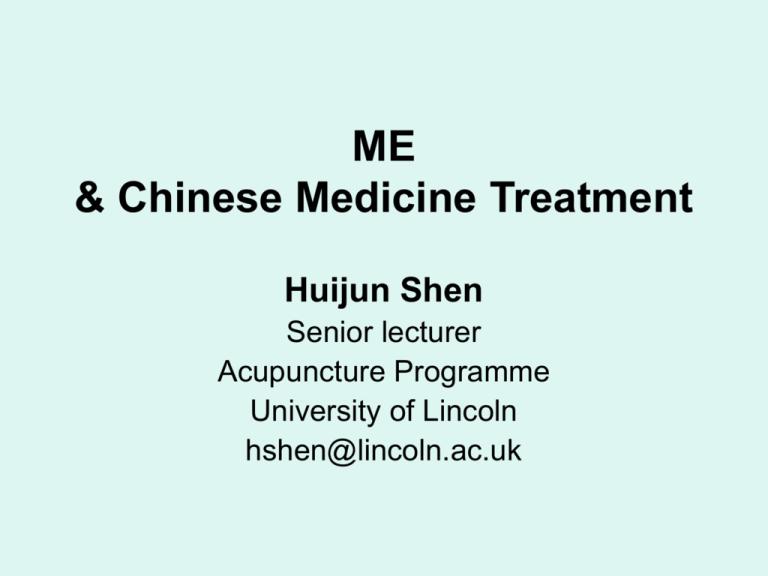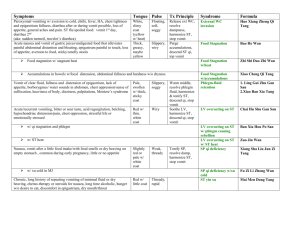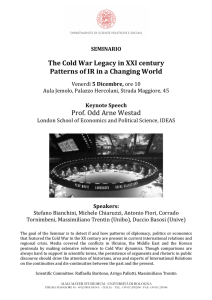ME & Chinese Medicine Treatment - The Institute of Chinese Medicine
advertisement

ME & Chinese Medicine Treatment Huijun Shen Senior lecturer Acupuncture Programme University of Lincoln hshen@lincoln.ac.uk ME: TCM Understanding TCM Name: Xu Lao • Xu: Deficiency • Lao: Fatigue Core Etiology & pathogenesis: • Damp retention, and • Qi deficiency What is damp retention • An abnormal accumulation of body fluids, which affect the physical functions of organs (most commonly spleen), tissues (muscles etc) and cells, leading to dysfunction of cellular metabolism. • Damp: intercellular accumulation of body fluids? Where does damp retention come from? Damp retention leading to Spleen dysfunction • Spleen has the function in transformation and transportation of food essence to produce Qi Exogenous Damp: Damp environment, damp weather, etc. Damp accumulating in Middle Jiao Endogenous damp: Cold food/ unhealthy diet Spleen Dysfunction Xu Lao What is Qi Deficiency? • Qi: life force, vital energy • Qi deficiency: Qi becomes weaker than normal leading to lessened energy level in the body, manifesting as fatigue/lethargy, weak muscles, poor appetite, weak voice, pale tongue and weak pulse. Where does Qi Deficiency come from? Typical Qi Deficiency is Spleen Qi Deficiency Congenital Weakness Too little production long term illness erratic diet malnutrition Too much consumption long term illness overwork Spleen Deficiency - Failing to produce Qi, Qi becomes weak Spleen Qi Deficiency failing to transform and transport body fluids, leading to Damp retention Damp Retention vs Spleen Qi Deficiency mutually causative mutually consequent Damp Retention Spleen Qi Deficiency A. Early stage: predominantly excess patterns • Damp accumulated in the interior 1. Damp heat accumulated in the interior • Main symptoms: • feeling slightly hot but no fever, sweating, thirst but no desire for drinking; • distension/fullness in abdomen, with dull pain, poor appetite, erratic bowel movement or diarrhoea, nausea, vomiting; • red tongue with yellow greasy coating, rapid soft pulse. • Treatment principles: Clear damp heat • Herbal formulae: San Ren Tang • Herbal prescription: Xing Ren, Sha Ren, Yi Yi Ren, Huan Qin, Zhi Zi, Bai Zhu, Chen Pi, Gan Cao • Point selection: GB34, SP9, ST38, ST25, LI11 • 2. Damp cold accumulated in the interior • Main symptoms: feeling cold, no or little sweating, no desire for drinking, distension/fullness in abdomen, poor appetite, nausea, erratic bowel movement or diarrhoea, pale tongue with white greasy coating, slow soft (soggy) pulse • Treatment principles: expel cold and remove damp • Point selection: GB34, SP4, SP6, SP9, ST36, ST38, ST25, Ren 12, Ren6, or moxa • Treatment principles: expel cold and remove damp • Herbal formulae: Ping Wei San with Huo Zhu Wan • Herbal prescription: Cang Zhu, Hou Po, Chen Pi, Sha Ren, Yi Yi Ren, Huo Xiang, Bai Zhu, Gan Cao, Fu Ling, • Point selection: GB34, SP4, SP6, SP9, ST36, ST38, ST25, Ren 12, Ren6, or moxa • 3. Damp /phlegm retention combined with Liver Qi stagnation • Main symptoms: • no feeling cold or hot • distension/fullness in abdomen, or abdominal pain • poor appetite, nausea • or fullness in chest with cough and phlegm • erratic bowel movement or diarrhoea • irregular or painful menstruation • irritability, frequent sighing • pale tongue with white greasy coating, pulse soft in spleen position and wiring in liver position • Treatment principles: remove damp/phlegm and spread liver qi • Herbal formulae: Er Chen Tang with Si Ni San • Herbal prescription: Chen Pi, Ban Xia, Fu Ling, Gan Cao; Chai Hu, Bai Shao Yao, Zhi Shi; plus Qing Pi, Yu Jin, Xing Ren. • Point selection: Liv3 (or with LI4), GB34, SP4, SP6, SP9, ST36, ST40, ST25, Ren 12, Ren6, Liv13, Liv14. B. Middle Stage: predominantly deficiency patterns • 1. Qi deficiency mingled with damp • Main symptoms: Fatigue, low energy level, poor appetite, loose stools or even diarrhoea, weight loss, pale tongue with teeth marks on the tongue edge, weak pulse. • Treatment principles: tonify spleen Qi and remove damp • Herbal formulae: • Herbal prescription: • Point selection: ST36, SP3, SP6, SP9, Ren 6, Ren 12, BL20 • 2. Qi and blood deficiency • Main symptoms: Fatigue, low energy level, pale complexion, poor appetite, loose stools or even diarrhoea, more obvious weight loss, abnormal menstruation in women, dizziness when feeling tired, numbness in limbs, blurred vision, pale tongue and weak pulse. • Treatment principles: Tonify Qi and nourish blood • Herbal formulae: Ba Zhen Tang • Herbal prescription: Dang Sehn, Bai Zhu, Fu Ling, Gan Cao; Dang Gui, Bai Shao Yao, Shu Di Huang, Chuan Xiong; Huang Qi, Shan Yao, He Shou Wu can be added. • Point selection: ST36, SP6, SP10 Ren 6, BL17, BL18, BL20. • 3. Yin deficiency • Main symptoms: Feeling hot or hot flushes, night sweats, dry mouth and thirst, “five palm heat”, weight loss, fatigue, red tongue with little coating, weak/thin and rapid pulse. • Treatment principles: Nourish Yin • Herbal formulae: Liu Wei Di Huang Wan plus • Herbal prescription: Shu Di Huang, Shan Yao, Shan Zhu Yu, Mu Dan Pi, Ze Xie, Fu Ling; Mai Men Dong, Nu Zhen Zi, Gou Qi Zi, Tai Zi Shen can be added • Point selection: SP6, BL18, BL23, Ren4; KI2, 6 or 7 • 4. Yang deficiency • Main symptoms: Feeling cold with cold hands and feet, lack of sweats, weight loss, very tired with low energy, obvious general weakness, loose stools or diarrhoea, frequent urination, pale or purple tongue, deep weak pulse. • Treatment principles: tonify Yang • Herbal formulae: modified Jing Gui Shen Qi Wan • Herbal prescription: Xian Mao (as substitute of Fu Zi), Rou Gui, Shu Di Huang, Shao Yao, Shan Zhu Yu, Mu Dang Pi, Ze Xie, Fu Ling; Tu Si Zi, Ba Ji Tian can be added. • Point selection: KI3, 6, 7; BL20, 23; Ren4, 6; DU4, ST36 C. Later Stage: predominantly multiple deficiency patterns • 1. Qi and Yin dual deficiency • Main symptoms: Extreme weakness, feeling hot or hot flushes, night sweats, dry mouth and thirst, “five palm heat”, weight loss, fatigue, poor appetite, erratic bowel movement, red tongue with teeth marks, little tongue coating, weak, thin and rapid pulse. • Treatment principles: Tonify Qi and nourish Yin • Herbal formulae: Bao Yuan Jian with Liu Wei Di Huang Wan • Herbal prescription: Dang Shen, Bai Zhu, Huang Qi, Fu Ling, Chen Pi, Gan Cao; Shu Di Huang, Shan Yao, Shan Zhu Yu, Mu Dan Pi, Ze Xie; or Sheng Mai Yin (Ren Shen, Mai Men Dong, Wu Wei Zi) can be added. • Point selection: ST36, SP6, BL18, BL20, BL23, Ren 4 Ren 6; KI 2, 3, 6 or 7 • 2. Yin and Yang dual deficiency • Main symptoms: Extreme weakness, no hot or cold feeling, or feeling warm/hot in the afternoon but cold at night or in the morning, night sweats and spontaneous sweats, severe weight loss, very poor appetite, deep and very thin/weak pulse. • Treatment principles: tonify Yang and nourish Yin • Herbal formulae: Liu Wei Di Huang Wan with Zhen Wu Tang • Herbal prescription: Shu Di Huang, Shan Yao, Shan Zhu Yu, Mu Dan Pi, Ze Xie, Fu Ling; Fu Zi (substituted by Xiao Mao), Gan Jiang, Bai Zhu, Bai Shao Yao; Rou Gui, Ba Ji Tian can be added. • Point selection: SP6, ST36, BL18, BL20, BL23, Ren4; KI2, 3, 6 or 7; Ren4, 6; DU4 Lifestyle Modification • • • • Balance Diet Adequate Rest Gentle exercise: Tai Ji, Yoga, etc. Spiritual relaxation: Meditation, enjoy life, have a good relationship • Family support • Social activity Balanced Diet • High protein food: red meat, fish • Vegetarian: may not be good for ME sufferers • Eating hot or cold food? Hot/Cold Property of Common Food 常用食物的寒热属性 Warm or Hot Food 温热性食物 (more suitable to people with cold constitution or cold pattern of illness) Neutral Food 中性食物 (suitable to all) Cool or Cold Food 寒凉性食物 (more suitable to people with heat constitution or heat pattern of illness) Meat Lamb, chicken, goose, prawn, 羊肉, 鸡肉, 鹅肉, 海虾 Pork, beef 猪肉, 牛肉 Crab, most sea food, rabbit, duck, pig liver, donkey 螃蟹, 多数水产品, 兔肉, 鸭, 猪肝, 驴肉 Vegetable Eggplant, onion, chive, garlic, pepper, 茄子, 洋葱, 韭菜, 大蒜, 辣椒, 姜, 茴香 Potato, Chinese Yam 土豆, 山药 Seaweed, Chinese leaf, cabbage, spinach, carrots, celery, cucumber, wax gourd, gourd, lotus root, tomatoes, green bean 海带, 白菜, 菠菜, 萝卜, 芹菜, 黄瓜, 冬瓜, 葫芦, 莲藕, 西红柿, 绿豆 Fruits Longan, litchi chinensis, chestnut, walnut, citrus, 龙眼, 荔枝, 栗子, 胡桃, 橘类 Peach, apricot, grape 桃, 杏, 葡萄 Pears, watermelon, melon, persimmon, banana, pineapple 梨, 西瓜, 甜瓜, 柿, 香蕉, 菠萝 Others Brown sugar, syrup, wine, coffee, curry 红糖,饴糖,酒,咖啡,咖喱 Chicken egg 鸡蛋 Sugar, ice sugar, tofu, duck egg 白糖, 冰糖, 豆腐, 鸭蛋 Qi Tonic herbs • Ginseng (Ren Shen) – – – – Chinese ginseng Korean ginseng Siberian ginseng American ginseng • Other Qi tonic herbs: – – – – Huang Qi Dang Shen Bai Zhu Shan Yao Damp Removing herbs • • • • Cang Zhu Hou Po Huo Xiang Sha Ren




